2022 Pipeline Report: Capitalizing on Opportunity
Our annual report takes a look at pharma’s current investment in drug development, which this year demonstrates a focus on five important therapeutic areas of interest—Alzheimer’s disease, ophthalmology, NASH, anti-infectives, and opioids.
Diseases shape history. They shape lives. The emerging drugs in the development pipeline show promising results in treating some of the most virulent ailments in modern society. Moreover, these new drugs are the end result of accelerating innovations in next-generation pharmaceutical technologies that aim to change the face of medicine. Emerging products like phage therapies, biologics, gene therapies, monoclonal antibodies, and next-generation anti-infection/anti-microbial agents are opening up new opportunities in verticals like pain management, ophthalmology, infection control, fatty liver disease, and Alzheimer’s disease.
The drug development pipeline is filled with promising new products, and several of them are close to commercialization. These drugs are aiming to reshape the course of history; the ones that succeed will serve as best-in-class products for pharmaceutical companies that embrace innovation.
Several of these new products, like long-acting GLP-1 analogues and anti-beta amyloid monoclonal antibodies, are in Phase III trials and could be ready for commercialization shortly. Other experimental therapies, like phage-based antimicrobials and intravitreal injectable drugs for ophthalmological conditions, are winding their way through preclinical and Phase I studies.
Pharm Exec’s 17th Annual Pipeline Report showcases the most promising and innovative new therapies under development, with data provided by Clarivate Analytics.
The search for an Alzheimer’s breakthrough
Alzheimer’s drugs have pivoted in recent years as the working theory of the disease evolves. Clarivate’s data shows that from 2000 to 2010, the most common biomarker pursued in drug studies was amyloid beta A4 protein. Over the past 11 years, though, this has shifted. There is significant new interest in microtubule-associated protein tau, with 286 clinical trials tracking that biomarker since 2010—a 13-fold increase over the previous time period.
This shift is taking place at the same time that aducanumab, a monoclonal antibody that targets amyloid beta plaque in the brain, faces ongoing controversies and challenges. FDA approved aducanumab, under the brand name Aduhelm, in June 2021 over the fierce objections of its own advisory committee members. Harvard Medical School professor and former FDA advisory committee member Aaron Kesselheim, MD, JD, called the Aduhelm approval “probably the worst drug approval decision in recent US history.”1
All charts can be enlarged by clicking
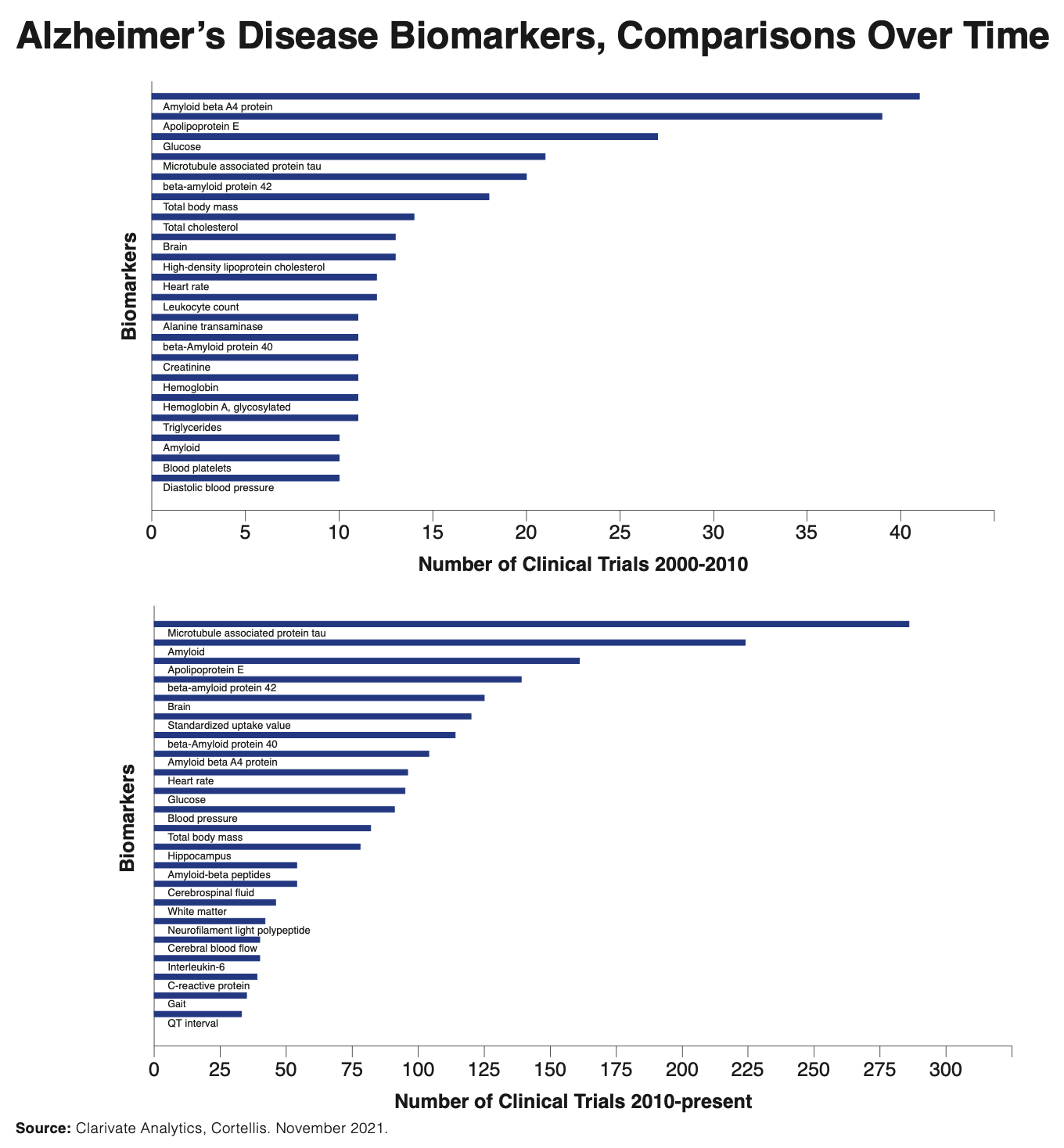
Since its approval, Aduhelm has underperformed relative to expectations. Despite being the first Alzheimer’s drug to gain FDA approval since 2003, the drug amassed only $300,000 in sales in its first three months on the market. Analysts had expected the drug to earn $14 million in Q3-2021. Some experts have questioned whether the drug offers clinical benefits that justify its risk of side effects like cerebral hemorrhaging.2
Michael Kleinrock, lead research director at IQVIA, says the problem with aducanumab and other drugs like it is that there is only a very limited correlation between amyloid plaque reduction and an observable endpoint. That’s why, he says, the bulk of the Alzheimer’s pipeline is examining other pathways. While some plaque-targeting drugs, like lecanemab,3 gantenumerab, and solanezumab, continue to undergo Phase II and Phase III trials, there is also growing interest in drugs that treat other aspects of Alzheimer’s.
Mike Ward, head of global thought leadership for Clarivate in London, says the growth of research activity in Alzheimer’s drugs is cause for optimism. He notes that a successful pharmaceutical treatment that could meaningfully prevent cognitive decline would be not only a commercial success but a social one: “The economic cost of Alzheimer’s disease is a drain on family resources. Caregivers are often close family members. There would be a tremendous benefit, both at the individual level and the society-wide level, if there were a meaningful breakthrough that could stop cognitive decline.”
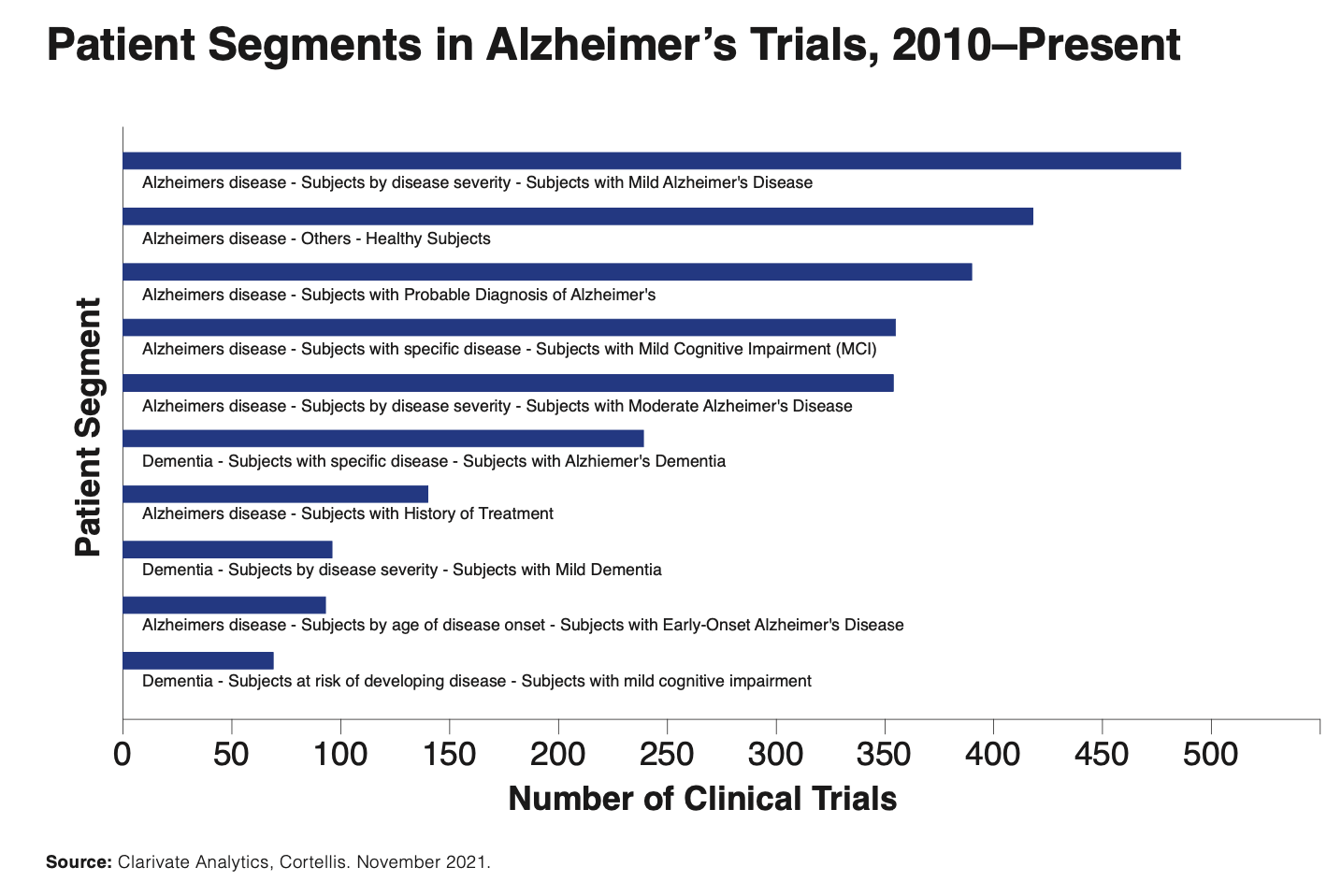
The goal of stopping cognitive decline is driving diversification in the types of drugs under development, several of which are disease-modifying small-molecule drugs and biologics. Disease-modifying biologics like the PKC agonist bryostatin-1 and the peptide GV1001 are in Phase II trials; disease-modifying small-molecule drugs like GV-971 and NE3107 have progressed to Phase III studies.4 In the case of GV-971, an oligosaccharide compound derived from brown algae, a Phase III trial published in 2021 showed that treatment with GV-971 caused a statistically significant improvement in patients’ ADAS-Cog-12 scores compared to placebo, and the drug was found to be safe and well tolerated.5
Meanwhile, drugs like troriluzole and tricaprilin are under investigation for their potential to work on the nervous system level to modulate disease symptoms. Troriluzole, a glutamate modulator from Biohaven Pharmaceuticals, is undergoing Phase II and Phase III studies for a variety of psychiatric and neurodegenerative disorders. While troriluzole has experienced struggles in trials,6 Biohaven is expected to continue studying the drug for use in patients with mild Alzheimer’s.
Tricaprilin, in contrast, received a boost in October 2021 when manufacturer Cerecin, formerly Accera, announced a new $40 million round of financing for pipeline development.7 Tricaprilin is a medium-chain triglyceride that promotes mitochondrial metabolism and induces ketosis. In 2013, Accera ran afoul of FDA with its branded tricaprilin product, Axona, which the company had been marketing as a medical food. FDA determined that Axona did not fit the legal definition of a medical food under the Federal Food, Drug, and Cosmetic Act. However, Cerecin has continued to develop Axona in the form of a pharmaceutical drug under the developmental name AC-1204.
One Phase III trial, completed in August 2021, showed that tricaprilin caused a 0.6-point improvement in ADAS-Cog11 scores after 26 weeks, while the placebo did not change scores from baseline. The study authors determined this difference was not statistically significant, but hypothesize that the failure to prove efficacy may have resulted from a lower-than-expected level of ketone production and the placebo group’s better-than-expected performance.8 A new formulation of the drug, code named AC-SD-03, will be undergoing further Phase III trials in 2022.
Several of the other Alzheimer’s candidates under development are symptom-reducing drugs that target specific cognitive, emotional, or behavioral symptoms of Alzheimer’s, with the aim of managing symptoms like agitation, loss of awareness, and sleep disturbances.
Nabilone, a synthetic cannabinoid and THC biosimilar currently approved for chemotherapy-induced nausea, is undergoing clinical trials to determine if it can treat agitation in Alzheimer’s patients. It has been found to be moderately effective at reducing Cohen-Mansfield Agitation Inventory (CMAI) scores. The drug also decreased overall neuropsychiatric symptoms and caregiver distress, improved cognition, and was more effective at reducing agitation than atypical antipsychotics.9 This is an important breakthrough given the recent failures of other symptom-reducing medications in trials.
The tetracyclic antidepressant mirtazapine, an alpha-1 antagonist, had previously been recommended as a treatment for Alzheimer’s-associated agitation and mood disturbances.10 However, recent research is questioning mirtazapine’s value in Alzheimer’s treatment. A 2021 trial on 204 patients with probable Alzheimer’s that did not respond to non-pharmaceutical intervention found that a 45mg-daily dose of mirtazapine did not significantly change scores on the CMAI relative to placebo after 12 weeks. There were also seven deaths in the treatment group, compared to one in the control group.11
Meanwhile, a Phase III trial of azeliragon, a small-molecule RAGE inhibitor under development by vTv Therapeutics, was terminated in May 2021 after a failure to demonstrate efficacy at the 5mg dose.12 Azeliragon had previously shown efficacy in animal trials.13 Manufacturer vTv Therapeutics of High Point, N.C., has since entered into a licensing agreement with Cantex Pharmaceuticals to continue developing azeliragon as a cancer drug.14
Ophthalmology development accelerates; gene therapy dominant
Drug development for ocular diseases has grown significantly in recent years. Data provided by Clarivate shows that the number of clinical trials for ophthalmology drugs and drugs targeting ocular disease has grown by a factor of four over the past 20 years. From Jan. 1, 2000, to Jan. 1, 2010, there were 2,608 clinical trials performed on ophthalmology drugs. From Jan. 1, 2010, to present, Clarivate’s data show 10,984 trials, an increase of 421%.
The major areas of development in ophthalmology drugs since 2010 have been glaucoma, ocular hypertension, and wet age-related macular degeneration (AMD), with an emphasis on modifying physiological biomarkers of disease. From 2010 to present, 4,234 trials involved small-molecule drugs, making small-molecule pharmaceuticals the dominant type of drug under development. During that same time period, there were 3,570 trials involving medical devices, 2,490 trials involving biologics, and 2,229 trials involving medical procedures. Of these more than 10,000 trials, 4,401 did not have an FDA-defined phase, while 1,833 are Phase II trials and 1,200 are Phase IV post-marketing surveillance trials. There are over 1,200 ophthalmology drugs that have entered Phase III trials since 2010, compared to 418 in the decade prior.
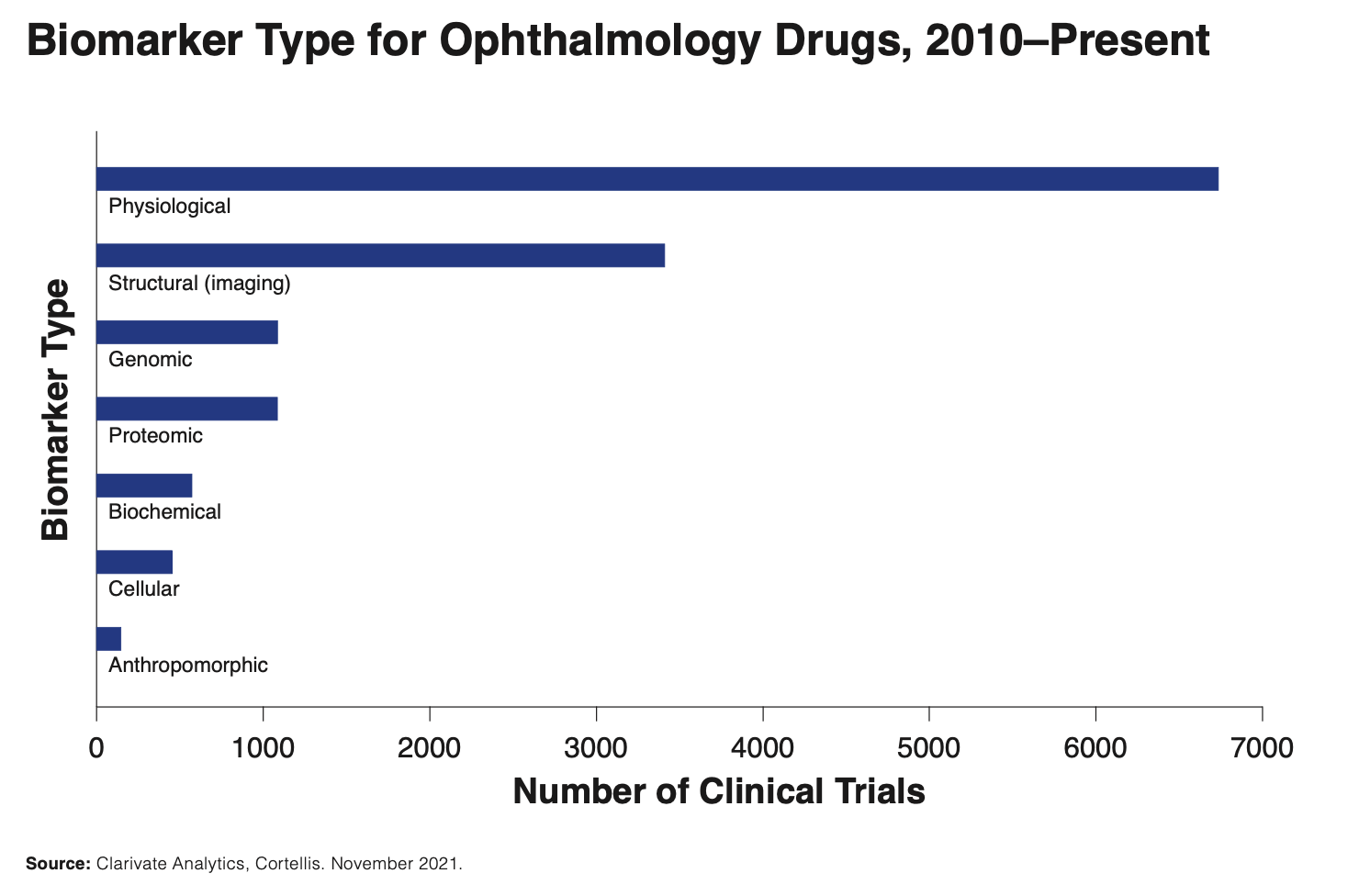
In September 2021, AbbVie signed a deal with Regenxbio to jointly develop and bring to market a single-treatment gene therapy for wet AMD and diabetic retinopathy called RGX-314. This gene therapy encodes an antibody fragment via the NAV AAV8 vector to inhibit the activity of vascular endothelial growth factor (VEGF). RGX-314 is designed to prevent fluid buildup in the retina by inhibiting blood vessel growth and leakage.
In October 2021, Regenxbio announced initial positive results from the Phase II ALTITUDE trial, which is investigating RGX-314 as a potential treatment for diabetic retinopathy. After three months, five of the 15 patients in the treatment group experienced at least a two-step improvement on the Early Treatment Diabetic Retinopathy Study-Diabetic Retinopathy Severity Scale (ETDRS-DRSS).
Drug companies are also looking at monoclonal antibodies for potential use in the ophthalmology market. Immunovant has been investigating its fully human FcRn monoclonal antibody IMVT-1401, formerly RVT-1401, as a potential treatment for myasthenia gravis (MG), a neuromuscular disease that can affect the muscles around the eyes, and thyroid eye disease. The company experienced a setback in February 2021 after subjects in the ASCEND GO-2 Phase IIb trial for thyroid eye disease exhibited an increase in total cholesterol and LDL levels. Later, in June 2021, Immunovant announced that it would continue developing IMVT-1401 at a lower dosage level. In July 2021, IMVT-1401 received Orphan Drug Designation for MG.
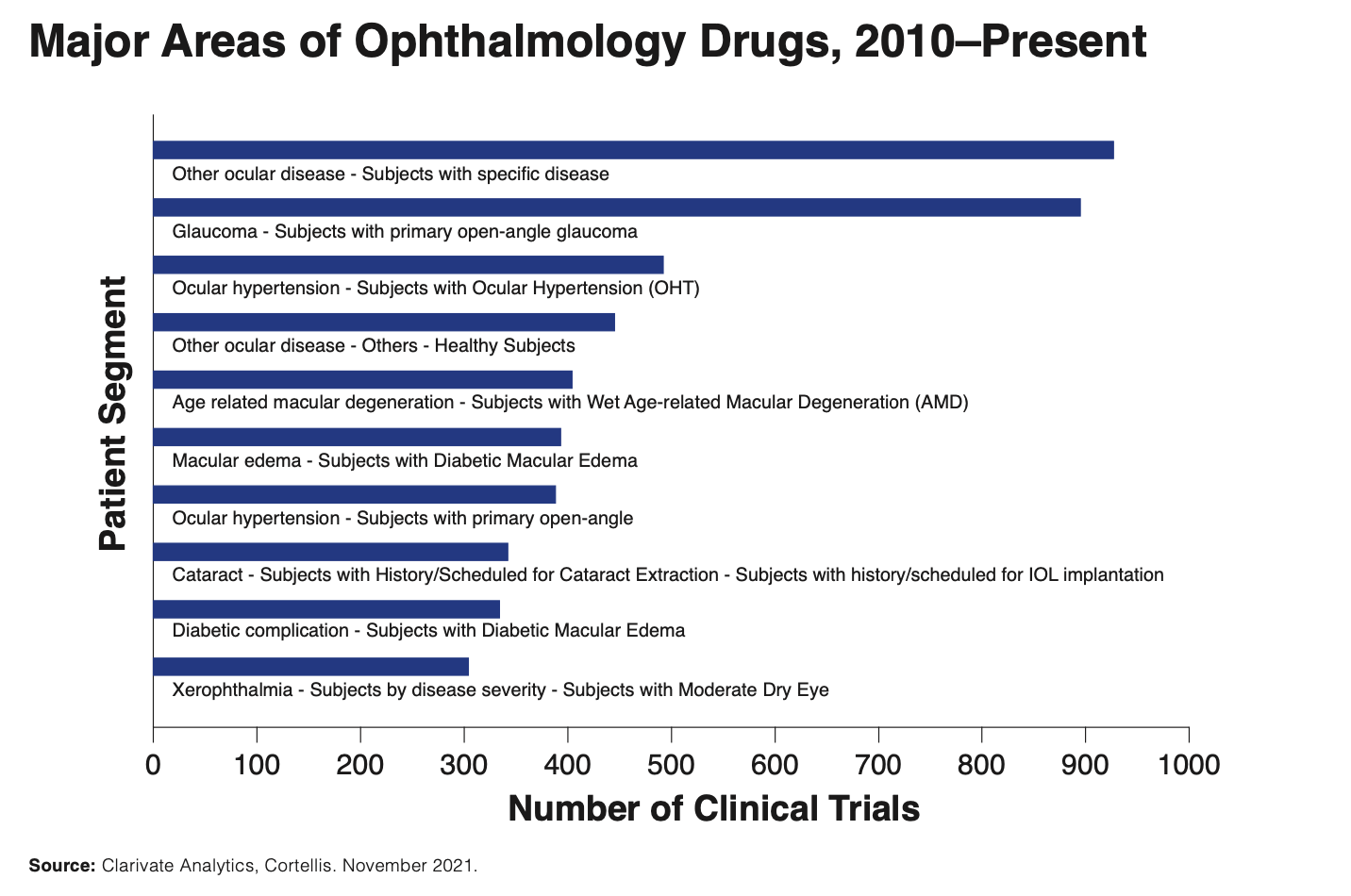
In October 2020, Novartis acquired Vedere Bio, a startup developing therapies that optimize surviving photoreceptors after vision loss. Vedere founder Cyrus D. Mozayeni, MD, launched Vedere Bio II, a sequel company developing a viral vector treatment for retinitis pigmentosa, an inherited form of vision loss. In May 2021, Vedere Bio II received $77 million in Series A funding in a financing round led by Octagon Capital.
Meanwhile, Visus Therapeutics has several candidates for multiple conditions in its pipeline. Brimochol, a combination of carbachol and brimonide tartrate administered in eye drops, is undergoing Phase II trials for treatment of presbyopia. Carbachol is a cholinergic miotic agent that constricts the pupils, while brominidine tartrate is a sympatholytic alpha-2 agonist that prevents the pupils from dilating. Five previous clinical studies have shown that Brimochol improves near-visual acuity. Visus Therapeutics’ four other candidates for the treatment of various ophthalmological conditions are currently in preclinical research. In August 2021, the company secured $20 million in financing from LSP and Sage partners. In November, it announced the appointment of David Guyer, MD, as chairman. Guyer formerly served as chair of the department of ophthalmology at the New York University School of Medicine and was the first person to develop and commercialize an anti-VEGF drug for macular degeneration.
NASH drugs navigate scientific and commercial challenges
Drugs for non-alcoholic steatohepatitis (NASH), the most severe form of fatty liver disease, have a history of struggles. In the Phase III REGENERATE study, obeticholic acid showed mixed results. FDA’s approval of obeticholic acid for treatment of primary biliary cholangitis in 2016 was regarded as a sign of hope that the drug might also be effective against NASH; the REGENERATE trial dashed those hopes when it found that the drug failed to resolve NASH after 18 months. While obeticholic acid did cause an improvement in fibrosis symptoms, this effect was only observed at the highest dose of 25mg/day.15
Other clinical trials of first-generation NASH drugs have also rendered disappointing results. In the RESOLVE-IT Phase III trial, GENFIT’s drug elafibranor did not resolve NASH without exacerbating fibrosis even after 72 weeks. In the STELLAR-3 and STELLAR-4 trials, selonsertib, a NASH candidate and ASK1 inhibitor developed by Gilead, did not result in statistically significant fibrosis improvements without exacerbating NASH symptoms after 48 weeks.16
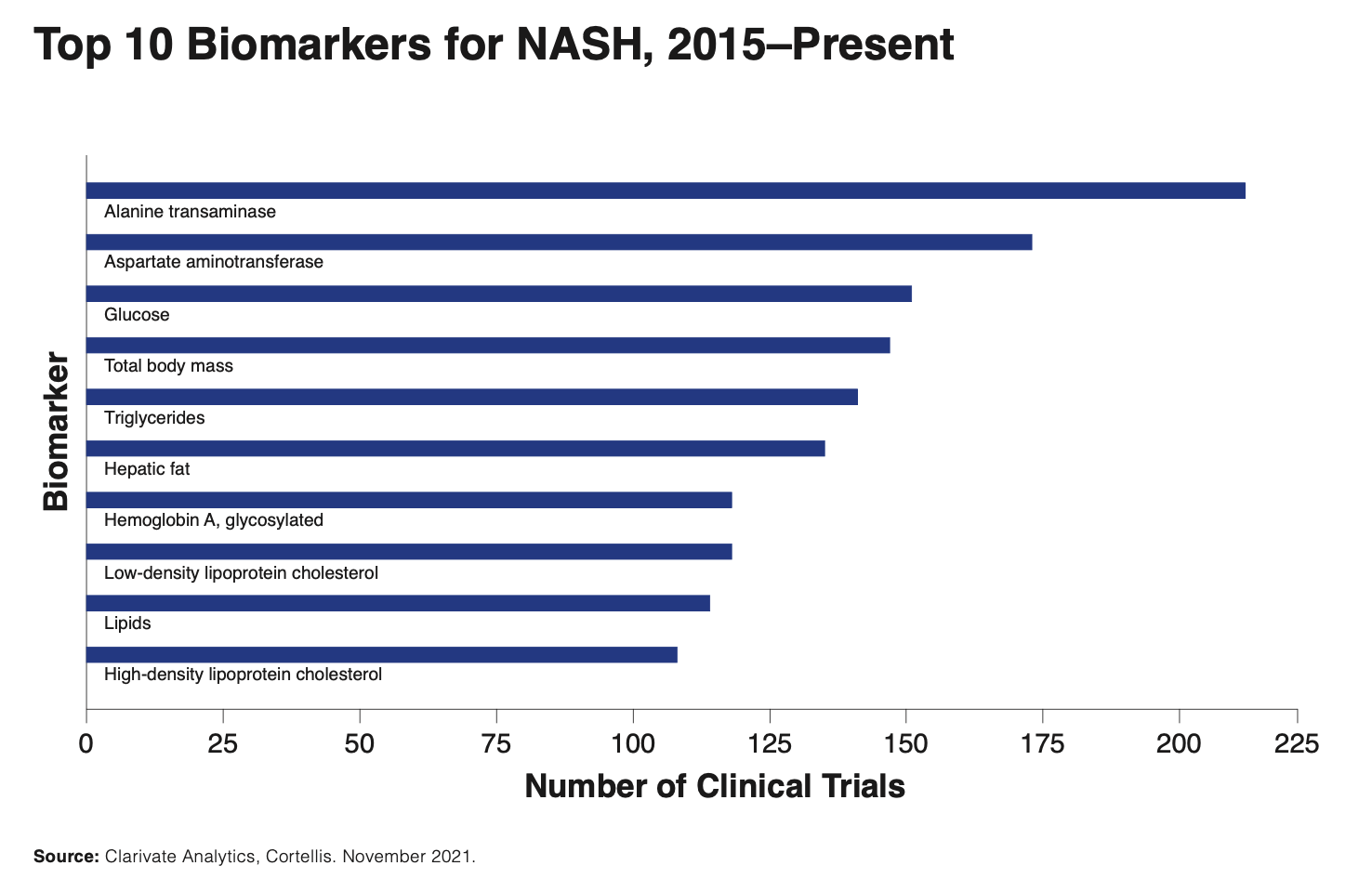
“The trials have underperformed,” says Kleinrock. “It’s a challenging dynamic to create a drug that has a response without side effects. If you think about the ecosystem surrounding NASH, these patients have diabetes and high cholesterol, maybe even metabolic syndrome. There’s some comorbidity with hypothyroidism and fatty liver disease. So it’s an interesting conundrum to come up with a drug that targets NASH.”
Now, though, a new generation of NASH drugs is winding its way through the research pipeline. Several new candidates are currently in Phase II and Phase III trials. Data provided by Clarivate shows that 363 NASH drug trials have taken place since Jan. 1, 2017; from 2000 to 2010, there were only 82 trials. The majority of NASH trials have historically involved small-molecule drugs. From 2010 to present, the most common biomarker assessed in trials was alanine transaminase, followed by aspartate aminotransferase and glucose.
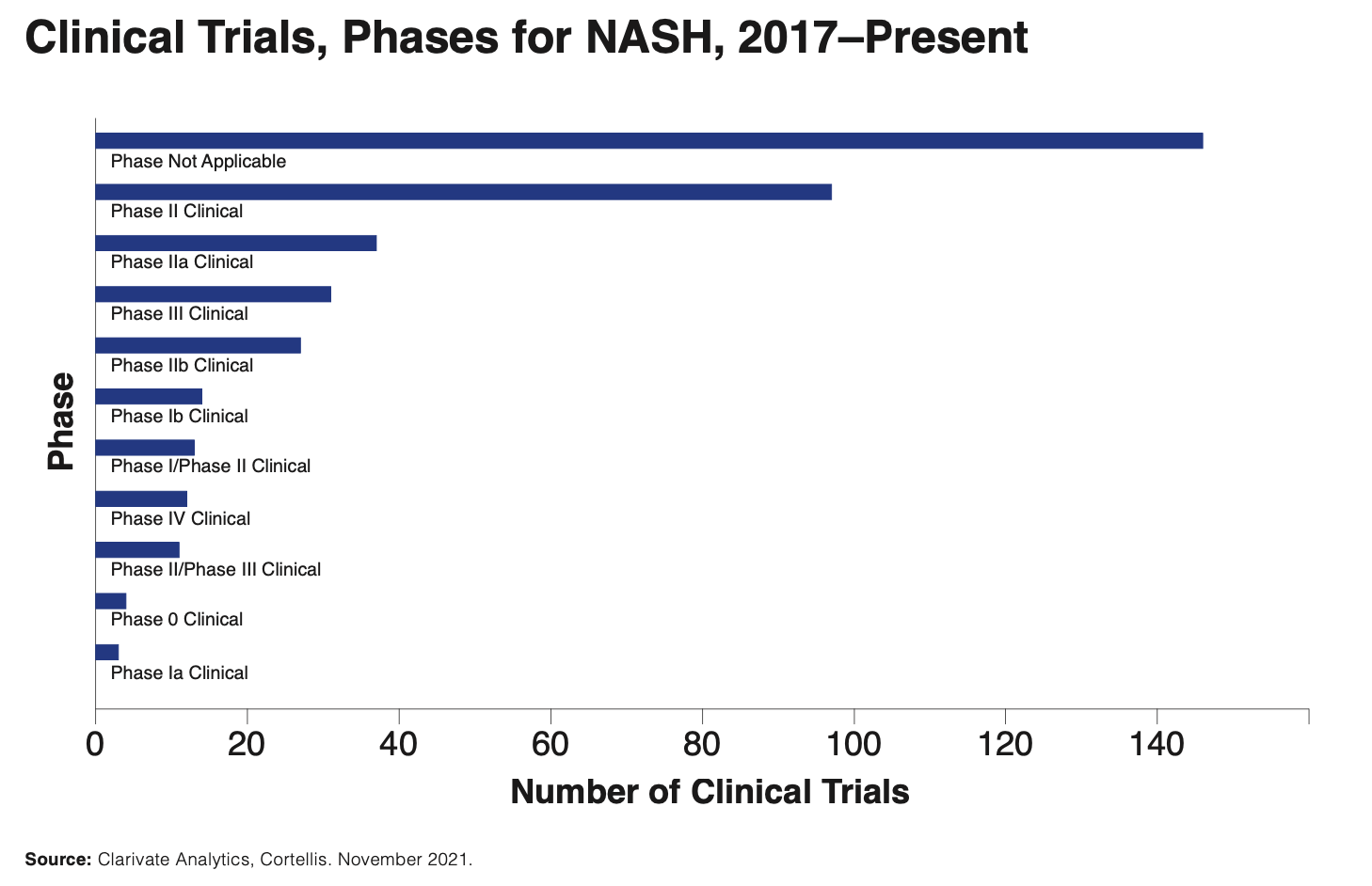
Kleinrock says that some of the emerging new drugs are beginning to show efficacy. Resmetirom (MGL-3196), for instance, has shown strong results in Phase II and Phase III trials. Resmetirom is a first-in-class, orally administered, small-molecule, liver-directed thyroid hormone receptor selective agonist produced by Madrigal Pharmaceuticals. The drug is undergoing two Phase III trials, the MAESTRO- NAFLD-1 trial for non-alcoholic fatty liver disease and the MAESTRO-NASH trial for NASH. The MAESTRO-NASH trial, involving 2,000 participants, is expected to end in March 2024.17 The MAESTRO-NAFLD-1 trial, involving 700 participants, will compare the effects of 80mg/day and 100mg/day of resmetirom vs. placebo among the blind participants and evaluate resmetirom’s efficacy at reducing biomarkers of NAFLD. Study completion is scheduled for December 2021.18
In September 2021, Galecto announced that it had commenced a Phase Ib/IIa trial investigating its galectin-3 inhibitor, GB1211, as a potential treatment for liver cirrhosis, a complication of advanced NASH. Initial data is expected in mid- to late 2022. AngioLab, a South Korean company, is developing an angiogenesis inhibitor made from lemon balm extract called ALS-L1023. The company published the results of an animal trial on ALS-L1023 in 2017; in September 2021, AngioLab completed a Phase IIa trial on ALS-L1023 for NASH. Also in September, Oramed Pharmaceuticals announced its Phase II trial of its NASH candidate, an oral insulin capsule developmentally coded ORMD-0801, had surpassed 50% enrollment.19
Some manufacturers are working on combination therapies—Allergan’s cenicriviroc and Novartis’ tropifexor—as possible NASH treatments, which have both separately received FDA fast-track status for NASH with liver fibrosis.
Cenicriviroc, which is also an experimental candidate undergoing study as a possible HIV and COVID-19 treatment, is a CCR2/CCR5 inhibitor. However, the Phase III AURORA trial on cenicriviroc was terminated early in April 2021 when the study’s initial results failed to show efficacy.20
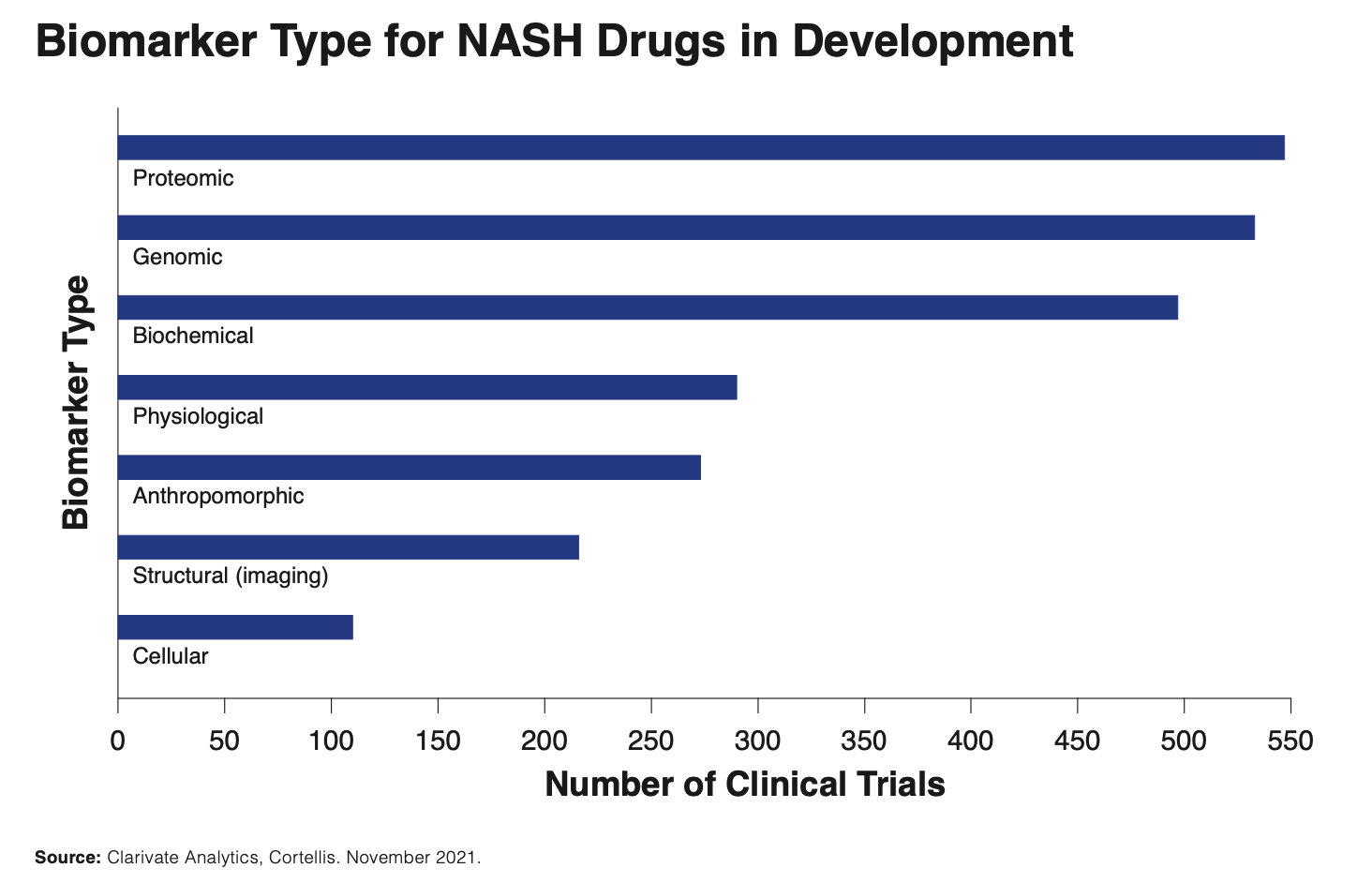
Tropifexor, a farnesoid X receptor agonist, was found to be effective at improving biomarkers of NASH like alanine aminotransferase, body weight, and hepatic fat fraction after 12 weeks, in Novartis’ Phase IIb FLIGHT-FXR study.21
Now, Novartis and Allergan are co-sponsoring a new Phase II randomized, double-blind, parallel-assignment trial to determine whether a combination of tropifexor and cenicriviroc is safe and effective in improving fibrosis or resolving NASH after 48 weeks. This trial, involving 193 participants, submitted results to the National Library of Medicine in October 2021 and is undergoing quality control review.22
Ionis Pharmaceuticals has two NASH candidates in its research pipeline, both of which are built on its antisense oligonucleotide technology. Ionis’ antisense therapies bind with mRNA to prevent the formation of disease-associated proteins. ION224 and ION839 are second-plus generation LICA medications designed to prevent the accumulation of liver fat by inhibiting diacylglycerol acyltransferase 2 and patatin-like phospholipase domain-containing 3 protein, respectively. Ionis is currently recruiting subjects for a Phase II trial of ION224. ION839, formerly AZD2693, was licensed to AstraZeneca in April 2018 and is currently undergoing a Phase I trial.
Another emerging NASH candidate is a repurposed drug first developed in 2012. Semaglutide is a GLP-1 analog that was originally approved as a treatment for diabetes in 2019. Earlier this year, the FDA approved Novo-Nordisk’s Wegovy (semaglutide) for chronic weight management. A 2021 Phase II trial on 320 patients with NASH and hepatic fibrosis examined whether a once-daily subcutaneous injection of 0.1mg, 0.2mg, or 0.4mg of semaglutide could resolve NASH without worsening fibrosis. Conducted by Novo Nordisk, the study found that at 72 weeks, 59% of subjects in the highest-dose semaglutide group achieved NASH resolution without worsening fibrosis, compared to 17% in the placebo group. The 0.2mg and 0.1mg doses achieved 36% and 40% NASH resolution, respectively.23
Other NASH drugs in development include Vonafexor, lanifibranor, and oltipraz. In July 2021, ENYO Pharma’s Phase IIA LIFIVY trial found that Vonafexor resulted in a 6.3% absolute liver fat reduction in the 100mg group and a 5.4% reduction in the 200mg group. The differences between placebo and Vonafexor were found to be statistically significant.24 A Phase IIb trial showed that high-dose lanifibranor caused resolution of NASH without worsening fibrosis in 49% of subjects. Low-dose lanifibranor achieved the same outcome in 39% of subjects, while 22% of subjects receiving a placebo achieved NASH resolution without worsening fibrosis.25 A Phase III trial on oltipraz by South Korean company Pharmaking was estimated to be completed in October 2021.26
Anti-infection solutions get creative
The anti-infection/anti-microbial category is seeing significant innovation, with non-traditional products in all stages of development. While large pharmaceutical giants have mostly exited this market, a new crop of emerging biotech startups has recognized a need for more anti-infection drugs and is actively developing innovative solutions. A March 2021 research report by Pew Charitable Trusts found that over 95% of anti-infection drugs in the pipeline are being developed by startups, and over 70% of these companies are pre-revenue.27
Kleinrock says that in anti-infection drugs, there has been a fundamental market failure in encouraging the amount of innovation required to solve the problems facing the niche. He notes that companies are still attempting to solve the problem of antimicrobial resistance, and in the meantime, the stopgap solution is to encourage less usage.
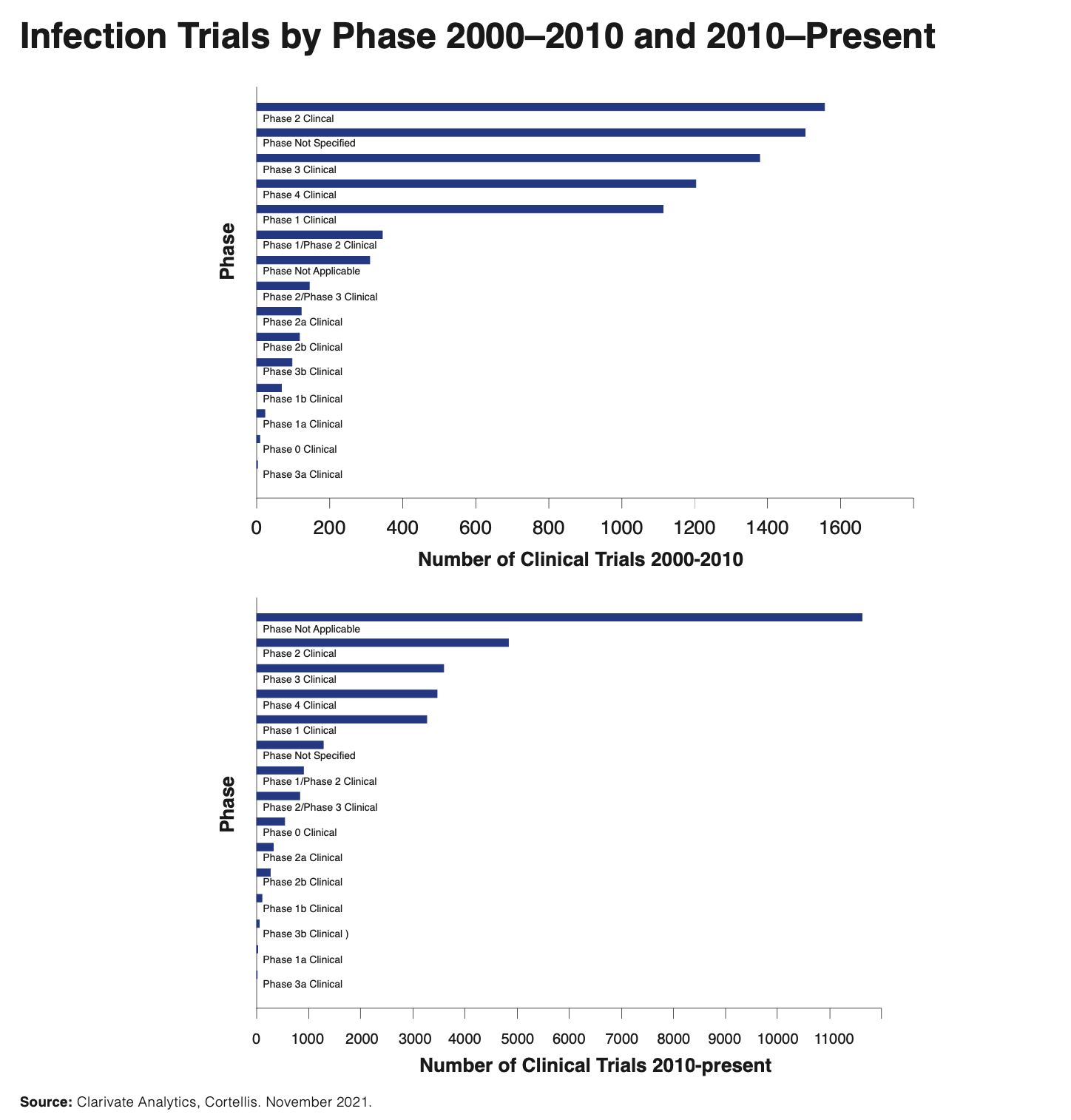
Despite the challenges that anti-infection drug development has historically faced, the pharma industry is beginning to take notice of antibiotic resistance. In July 2020, the World Health Organization and 20 of the world’s largest drug companies launched the AMR Action Fund, a biotechnology investment fund that intends to invest over $1 billion in biotech startups that are pursuing new antibiotics. The fund’s stated goal is to bring two to four new antibiotic drugs to market by 2030.
One of the areas of anti-infection drug development seeing significant research and investment is phage therapies. Several emerging biotech startups are developing phages that can solve the antimicrobial resistance challenge. Felix Biotechnology received a Phase I grant from the National Science Foundation in September 2021 to continue development of a machine learning platform that can match phages to the pathogens they are most effective against.28
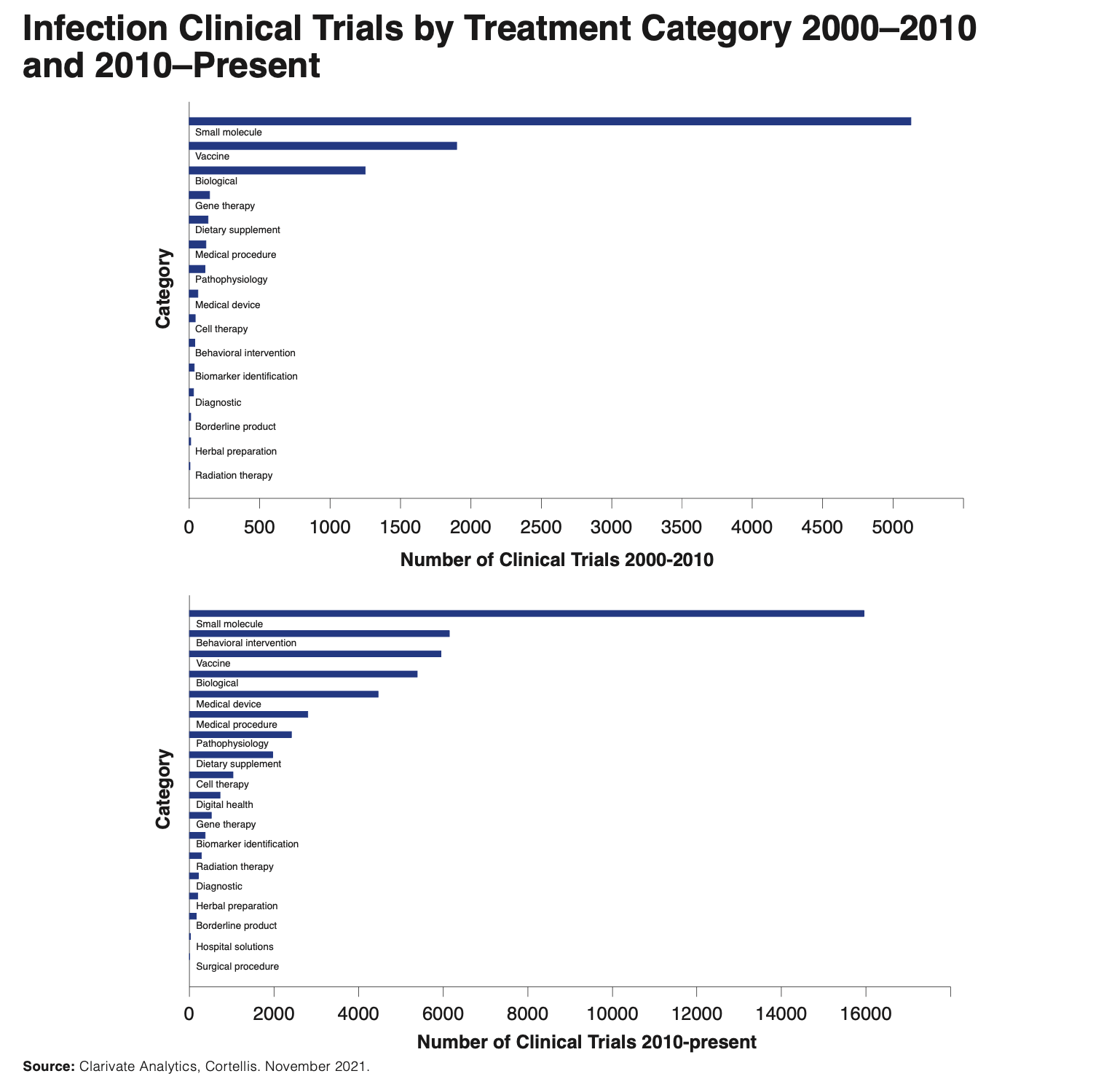
Armata Pharmaceuticals is developing multiple synthetic phage candidates. AP-PA02, a synthetic phage cocktail engineered to target P. aeruginosa, is under development for the treatment of respiratory infections in cystic fibrosis patients. AP-PA02 is the second generation of Armata’s initial phage product, AP-PA01. AP-PA01 showed favorable results in two case reports chronicled in Infection and the American Journal of Respiratory and Critical Care Medicine.29,30 Armata also is developing phage therapies for cystic fibrosis, pneumonia, bacteremia, and prosthetic joint infection.
Other phage candidates are in clinical development by Adaptive Phage Therapeutics. The company’s PhageBank library of phages has already received emergency IND authorization from FDA for use in treating diabetic foot osteomyelitis, prosthetic joint infection, chronic recurrent urinary tract infection, and cystic fibrosis-related lung infection. PhageBank also has emergency use Expanded Access IND status for treatment of secondary bacteremia in COVID-19 patients.
In September 2021, Adaptive Phage Therapeutics announced the results of a case study involving a 7-year-old with chronic, antibiotic-resistant P. aeruginosa infection following a car accident injury. The infection, located in the patient’s lower leg, continued to grow after surgical debridement and hardware removal. Seven weeks after treatment completion, the patient was able to bear weight without pain for the first time since the accident. At a five-month follow-up, the patient had no additional symptoms of bacterial infection.31
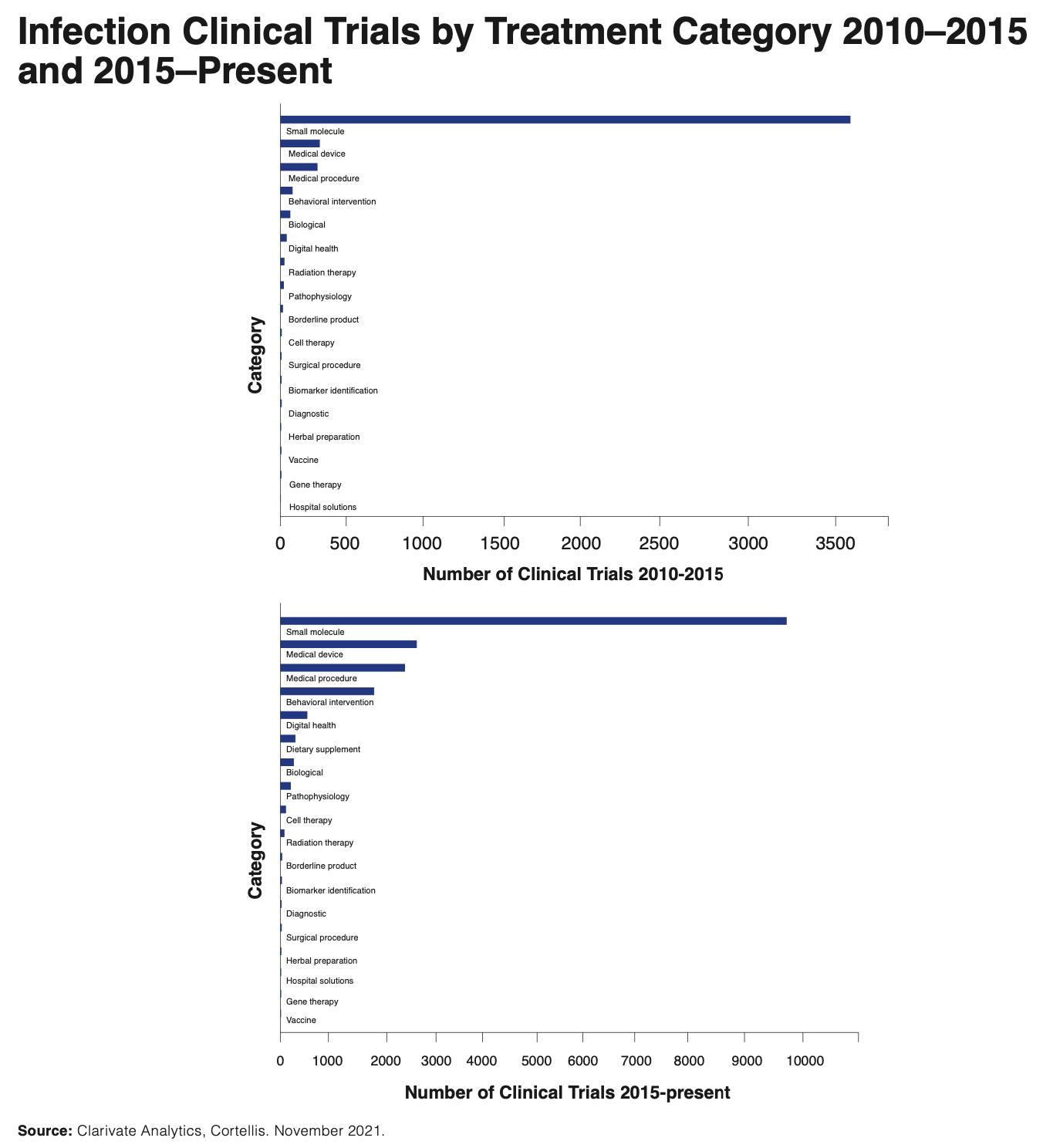
While phages are a compelling novel treatment, further research is required in order to make them viable. Kleinrock notes, “Phages are interesting because, conceptually, it’s a cool way to think about how we’re going to crack that nut, but I want to see more than one of them get past a certain level. Phase Ib and Phase II trials means we’re starting to figure out dosing and get a clinical effect.”
Some of the emerging anti-infection drugs that are currently undergoing Phase II and Phase III trials include omadacycline, AXC-362E, and fidaxomicin. Omadacycline is a tetracycline broad spectrum antibiotic in the aminomethylcycline subclass. Paratek Pharmaceuticals is developing omadacycline under the brand name NUZYRA as a treatment for non-tuberculous mycobacteria and pulmonary anthrax. NUZYRA is already approved for treatment of acute bacterial skin and skin structure infections, as well as community-acquired bacterial pneumonia. Paratek developed this form of tetracycline to overcome biological mechanisms that result in antibiotic resistance, and it has already shown efficacy against MRSA and drug-resistant Streptococcus pneumonia in trials.
Another unique drug is quickly making its way through the pipeline. Acurx Pharmaceuticals is developing ibezapolstat, a small-molecule bacterial DNA synthesis inhibitor. The drug is the first in a new class of Pol IIIC inhibitors for treatment of C. difficile. It has received a fast-track designation from FDA and has completed Phase IIa trials. Ibezapolstat is now in a Phase IIb trial slated for completion in March 2022. The company’s Phase IIa data showed that ibezapolstat had a 100% cure rate and eradicated colonic C. difficile within three days.32
Pain management drugs to end the opioid crisis
According to the National Institute on Drug Abuse, almost 50,000 Americans died of opioid overdoses in 2019. Despite the dangers of opioid addiction, the CDC reported in 2018 that an estimated 50 million Americans suffer from some type of chronic pain. The need for safe and effective pain management drugs still exists. That’s why much of the innovation in pain management involves engineering a pain medication that can provide opioid-level relief without the risk of addiction.
Kleinrock says the majority of development activity in pain drugs is in non-opioids. IQVIA’s research indicates that in December 2020, there were five opioid-based pain management drugs in development, compared to roughly 100 to 120 non-opioid analgesics. Kleinrock says that as of December 2020, there were also roughly 300 drugs in development designed to treat underlying diseases that produce pain as a symptom. Kleinrock says that while only a small subset of those drugs will complete Phase III trials, the diversity of approaches in drug types and the number of candidates in development are both reasons for optimism.
“I am very conscious of the significant amount of failures over the pipeline,” Kleinrock says. “But I tend to reason that if there’s a lot of activity in multiple mechanisms, with multiple companies looking at the same models, it’s more likely to make it through. There are some promising antibody and RNA approaches.”
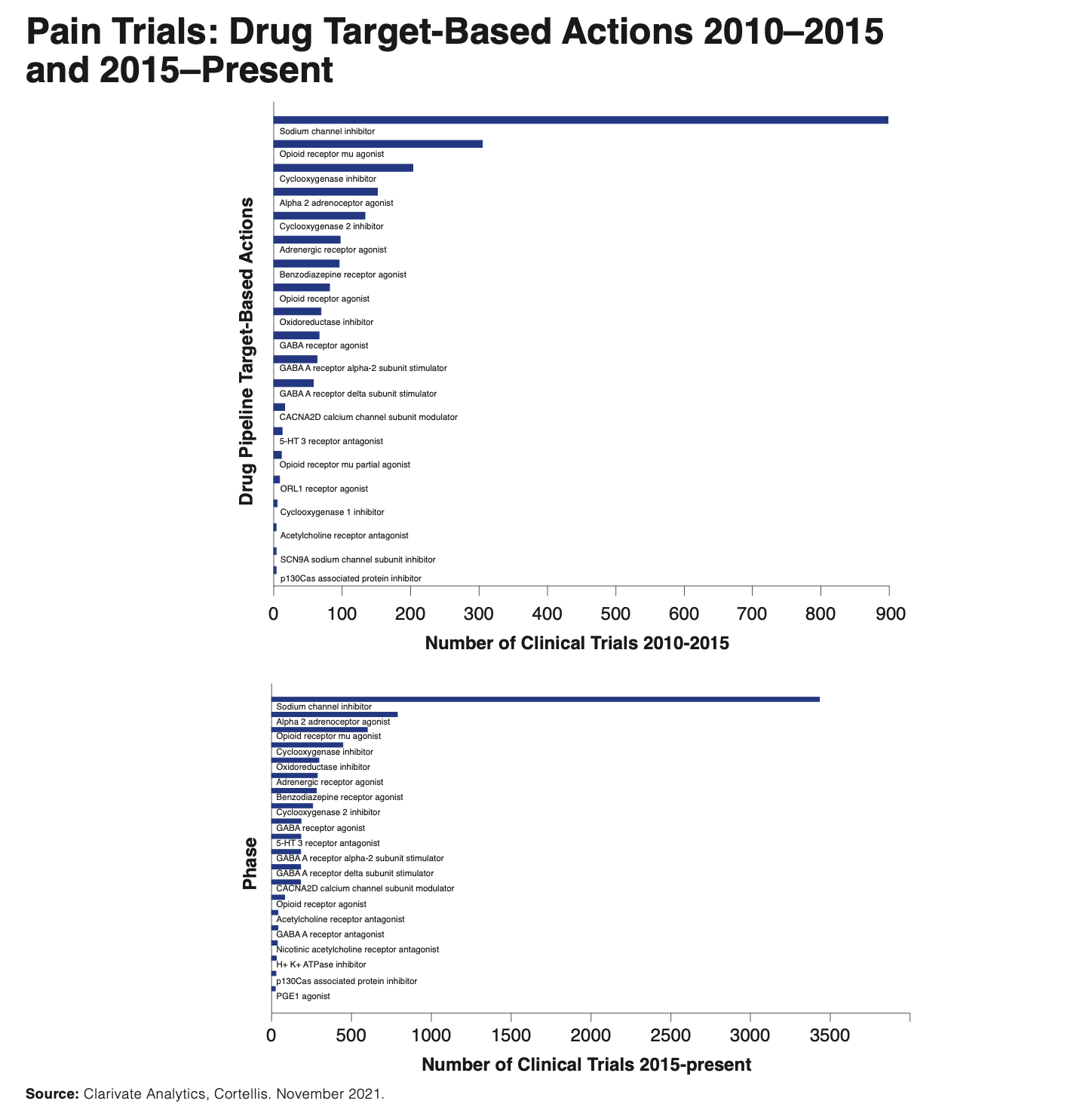
The next-generation pain management drug that is closest to commercialization is mirogabalin, a gabapentinoid and alpha-2-delta ligand developed by Daiichi Sankyo. Daiichi Sankyo sells the drug under the brand name Tarlige in Japan, where it was approved in January 2019. The drug’s Japanese approval is for the treatment of peripheral neuropathic pain, diabetic peripheral neuropathic pain, and postherpetic neuralgia. In May 2021, Daiichi Sankyo submitted a supplementary new drug application to the Japanese regulator to begin selling Tarlige for treatment of central neuropathic pain.
The US National Library of Medicine database shows 11 completed studies on mirogabalin. While the drug was previously under clinical development in the United States for the treatment of fibromyalgia pain, development was halted in the US and the European Union after mirogabalin failed to meet its primary endpoint in Phase III trials. However, new data shows that mirogabalin may be effective at treating specific types of neuropathic pain. A 2021 systematic review and meta-analysis of three randomized controlled trials with patients with diabetic peripheral neuropathic pain (DPNP) found that mirogabalin significantly reduced average daily pain scores (ADPS) relative to placebo. Mirogabalin also outperformed pregabalin after three, four, and five weeks.33
Some of the most revolutionary developments in pain management medicine are still in preclinical research. In August 2021, the Proceedings of the National Academy of Sciences published a mouse model study that determined that HMGB1 is a necessary component in the process leading to the inflammatory response.34 A 2019 literature review also found that a monoclonal antibody treatment targeting HMGB1 (HMGB1-nAB) has shown promise treating various CNS and PNS diseases, including neuropathic pain, in a variety of animal models.35 A subsequent literature review published in January 2021 found that HMGB1 is responsible for the development of neuropathic pain in patients with chemotherapy-induced peripheral neuropathy, which the authors say is resistant to most conventional pain medications.36
Some of the other emerging pain management candidates in development include AT-121, ML-351, RTI-5152-12, and a Nav1.7 gene therapy. All of these potential therapies are in preclinical research.
Strong science, creative thinking, and iteration fuel breakthroughs
The 2022 drug development pipeline is full of promising candidates in multiple stages of research and development, as well as some disappointing setbacks and failures. Several of these new pharmaceuticals, like phages, are first-in-class biologics that continue to undergo Phase Ib and Phase II studies. While these innovative products are likely 10 or more years away from commercialization, their creative approach holds promise in solving the challenge of antibacterial resistance. Other drugs, like resmetirom and AVP-786, have advanced to Phase III trials and are beginning to show efficacy in treating historically challenging conditions. Monoclonal antibodies are attracting interest for a variety of conditions like pain and ophthalmological conditions, with formulations at various stages of development in preclinical and clinical research. While several of these products still have many miles left to go on the long road to market approval, there are enough players in the industry ushering them along that for at least some of them, clinical and commercial success is inevitable.
About the Author
Mike Straus is a freelance writer based in British Columbia, Canada. His work has appeared in Nutritional Outlook, Hoist, and Massage Therapy Canada, among other publications.
References
- Chappell B. “3 experts have resigned from an FDA committee over Alzheimer’s drug approval.” NPR. Published online June 11, 2021.
- Hamilton J. “Cost and controversy are limiting use of new Alzheimer’s drug.” NPR. Published online Nov. 8, 2021.
- US National Library of Medicine. “A study to evaluate safety, tolerability, and efficacy of lecanemab in subjects with early Alzheimer’s disease.” ClinicalTrials.gov Identifier: NCT01767311.
- Cummings J et al. “Alzheimer’s disease drug development pipeline: 2021.” Alzheimer’s & Dementia Translational Research & Clinical Interventions, vol. 7 no. 1 (2021): e12179. Published online May 25, 2021.
- Xiao S et al. “A 36-week multicenter, randomized, double-blind, placebo-controlled, parallel-group, phase 3 clinical trial of sodium oligomannate for mild-to-moderate Alzheimer’s disease.” Alzheimer’s Research & Therapy, vol. 13 no. 62 (2021).
- Biohaven. “Biohaven provides update on phase 2/3 trial and Alzheimer’s disease program.” Published online Jan. 18, 2021.
- Cerecin. “Cerecin raises $40 million Series II and IIA financing to support its programs in neurological disorders.” Published online Oct. 19, 2021.
- Henderson ST et al. “A placebo-controlled, parallel-group, randomized clinical trial of AC-1204 in mild-to-moderate Alzheimer’s disease.” Journal of Alzheimer’s Disease, vol. 75 no. 2 (2020): 547-557.
- Herrmann N et al. “Randomized placebo-controlled trial of nabilone for agitation in Alzheimer’s disease.” American Journal of Geriatric Psychiatry, vol. 27 no. 11 (November 2019): 1161-1173.
- Cummings JL et al. “Guidelines for managing Alzheimer’s disease: Part II. Treatment.” American Family Physician, vol. 65 no. 12 (June 2002): 2525-2534.
- Banerjee S et al. “Study of mirtazapine for agitated behaviours in dementia (SYMBAD): A randomised, double-blind, placebo-controlled trial.” The Lancet, vol. 398 no. 10310 (Oct. 23, 2021): 1487-1497.
- US National Library of Medicine. “Evaluation of the efficacy and safety of azeliragon (TTP488) in patients with mild Alzheimer’s disease (STEADFAST).” ClinicalTrials.gov Identifier: NCT02080364.
- Yang L et al. “Azeliragon ameliorates Alzheimer’s disease via the Janus tyrosine kinase and signal transducer and activator of transcription signaling pathway.” Clinics (Sao Paulo) vol. 76 no. e2348 (2021). Published online March 1, 2021.
- vTv Therapeutics and Cantex Pharmaceuticals. “vTv Therapeutics and Cantex Pharmaceuticals announce strategic licensing agreement for development and commercialization of azeliragon for treatment of cancer.” Published online June 22, 2021.
- Lavitas P. “First wave of novel drugs for NASH does not live up to expectations, Clinical Pharmacy Service’s pipeline monitoring team finds.” Commonwealth Medicine. Published online Nov. 16, 2020.
- Dickson I. “No anti-fibrotic effect of selonsertib in NASH.” Nature Reviews Gastroenterology & Hepatology, vol. 17 (May 2020): 260.
- US National Library of Medicine. “A phase 3 study to evaluate the efficacy and safety of MGL-3196 (Resmetirom) in patients with NASH and fibrosis (MAESTRO-NASH).” ClinicalTrials.gov Identifier: NCT03900429.
- US National Library of Medicine. “A phase 3 study to evaluate the safety and biomarkers of resmetirom (MGL-3196) in non alcoholic fatty liver disease (NAFLD) patients (MAESTRO-NAFLD1).” ClinicalTrials.gov Identifier: NCT04197479
- Oramed. “Oramed’s Phase 2 oral insulin NASH trial reaches over 50% enrollment.” Published online Sept. 15, 2021.
- US National Library of Medicine. “AURORA: Phase 3 study for the efficacy and safety of CVC for the treatment of liver fibrosis in adults with NASH.” ClinicalTrials.gov Identifier: NCT03028740.
- Novartis. “Novartis data show tropixefor (LJN452) significantly improves several key biomarkers of NASH in patients with moderate to severe fibrosis.” Published online Nov. 11, 2019.
- US National Library of Medicine. “Study of safety, tolerability, and efficacy of a combination treatment of LJN452 and CVC in adult patients with NASH and liver fibrosis (TANDEM).” ClinicalTrials.gov Identifier: NCT03517540
- Newsome PN et al. “A placebo-controlled trial of subcutaneous semaglutide in nonalcoholic steatohepatitis.” The New England Journal of Medicine, vol. 384 no. 12 (March 25, 2021): 1113-1124.
- ENYO Pharma. “ENYO Pharma announces positive Vonafexor (EYP001) results for the LIVIFY Phase 2a study in F2-F3 NASH patients over 12 weeks.” Published online July 28, 2021.
- Francque SM et al. “A randomized, controlled trial of the pan-PPAR agonist lanifibranor in NASH.” The New England Journal of Medicine, vol. 385 no. 17 (Oct. 21, 2021): 1547-1558.
- US National Library of Medicine. “Oltipraz for liver fat reduction in patients with non-alcoholic fatty liver disease except for liver cirrhosis.” ClinicalTrials.gov Identifier: NCT04142749
- Pew Charitable Trusts. “Tracking the global pipeline of antibiotics development.” Published online March 9, 2021.
- Felix Biotechnology. “Felix Biotechnology awarded competitive grant from the National Science Foundation to power phage engineering platform.” PR Newswire. Published online Sept. 2, 2021.
- Law N et al. “Successful adjunctive use of bacteriophage therapy for treatment of multidrug-resistant Pseudomonas aeruginosa infection in a cystic fibrosis patient.” Infection, vol. 47 no. 4 (August 2019): 665-668.
- Maddocks SD et al. “Bacteriophage therapy of ventilator-associated pneumonia and empyema caused by Pseudomonas aeruginosa.” American Journal of Respiratory and Critical Care Medicine, vol. 200 no. 9 (November 2019): 1179-1181.
- Khatami A et al. “Bacterial lysis, autophagy, and innate immune responses during adjunctive phage therapy in a child.” EMBO Molecular Medicine, vol. 13 no. 9 (September 2021): e13936.
- Acurx Pharmaceuticals. “Acurx presents positive Ibezapolstat microbiome data from its Phase 2A trial at IDWeek.” PRNewswire. Published online Oct. 4, 2021.
- Alyoubi R et al. “Efficacy and safety of mirogabalin treatment in patients with diabetic peripheral neuropathic pain: A systematic review and meta-analysis of randomised controlled trials.” International Journal of Clinical Practice, vol. 75 no. 5 (May 2021): e13744.
- Yang H et al. “HMGB1 released from nociceptors mediates inflammation.” Proceedings of the National Academy of Sciences, vol. 118 no. 33 (August 2021): e2102034118.
- Nishibori M et al. “Anti-HMGB1 monoclonal antibody therapy for a wide range of CNS and PNS diseases.” Journal of Pharmacological Sciences, vol. 140 no. 1 (May 2019): 94-101.
- Sekiguchi F et al. “Role of HMGB1 in chemotherapy-induced peripheral neuropathy.” International Journal of Molecular Sciences, vol. 22 no. 1 (January 2021): 367.
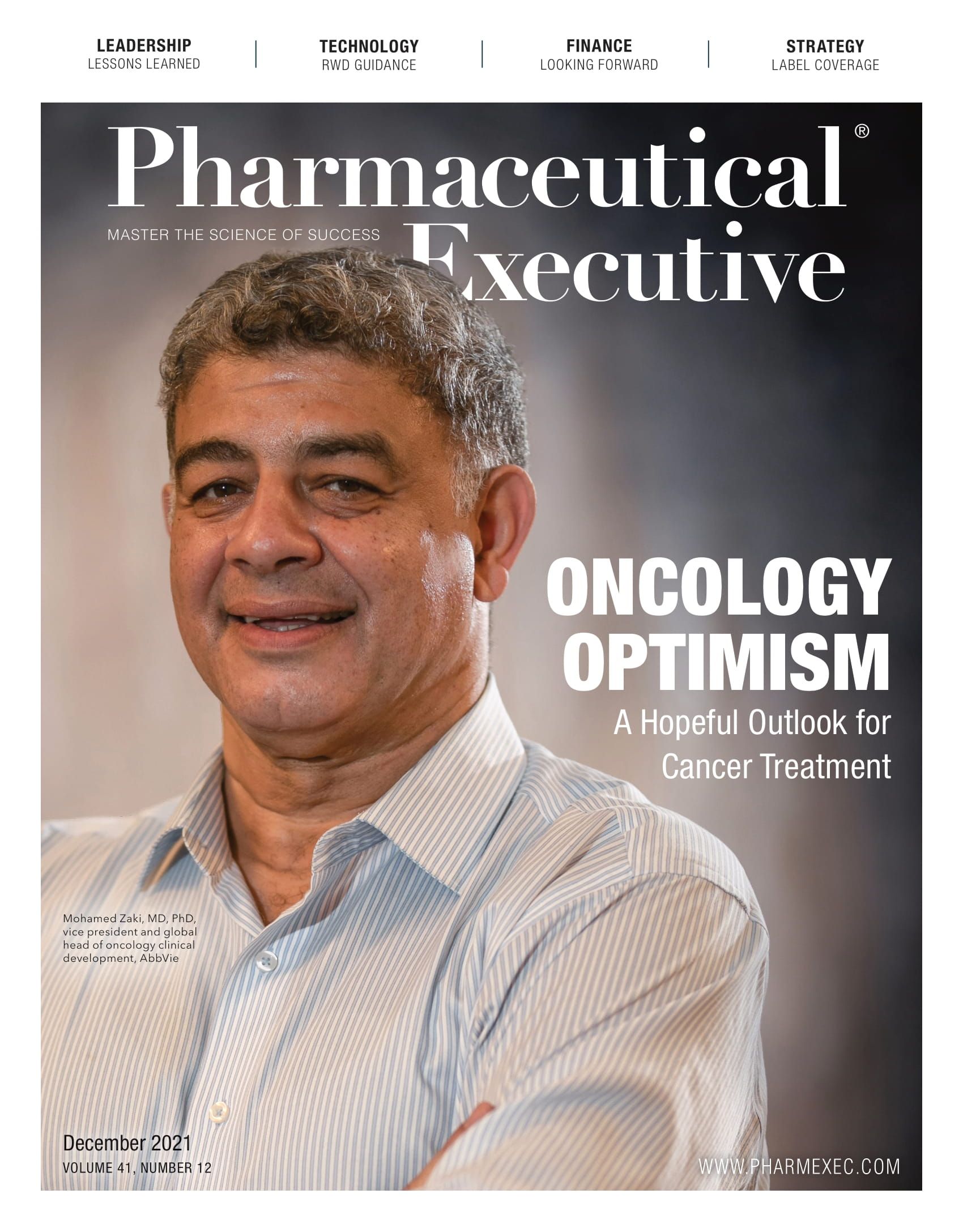
Addressing Disparities in Psoriasis Trials: Takeda's Strategies for Inclusivity in Clinical Research
April 14th 2025LaShell Robinson, Head of Global Feasibility and Trial Equity at Takeda, speaks about the company's strategies to engage patients in underrepresented populations in its phase III psoriasis trials.
Pfizer Discontinues Development of Danuglipron for Chronic Weight Management
April 15th 2025Despite meeting key pharmacokinetic goals, a potential case of drug-induced liver injury led Pfizer to conclude that danuglipron’s risk-benefit profile did not support further development for chronic weight management.
Key Findings of the NIAGARA and HIMALAYA Trials
November 8th 2024In this episode of the Pharmaceutical Executive podcast, Shubh Goel, head of immuno-oncology, gastrointestinal tumors, US oncology business unit, AstraZeneca, discusses the findings of the NIAGARA trial in bladder cancer and the significance of the five-year overall survival data from the HIMALAYA trial, particularly the long-term efficacy of the STRIDE regimen for unresectable liver cancer.